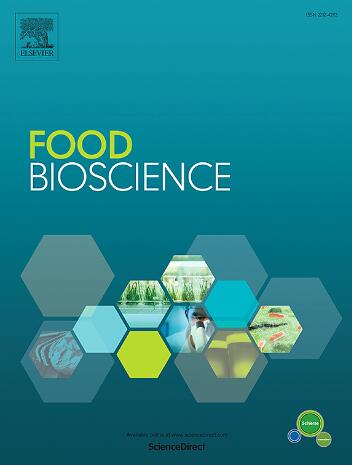荆芥精油纳米乳:抗氧化及食品保鲜的生物活性
IF 5.9
1区 农林科学
Q1 FOOD SCIENCE & TECHNOLOGY
引用次数: 0
摘要
本研究研究了木犀草精油基纳米乳液(SbEO- ne)的配方、稳定性和多功能生物活性,重点研究了与纯SbEO相比,其抗真菌、抗菌、抗氧化、抗炎和毒性等方面的增强。气相色谱-质谱(GC-MS)分析鉴定出百里香酚(45.49%)和香芹酚(30.11%)为主要成分,两者均具有有效的生物活性。以Tween 80浓度为1%、2%和3%,采用高能超声制备纳米乳液,其中2%的胶体稳定性最佳,液滴尺寸为亚微米级(PDI <0.3)。体外实验表明,与纯SbEO相比,SbEO- ne具有更好的抗菌效果,对尖孢镰刀菌孢子萌发的抑制作用更强(在1.3 mg/mL浓度下延迟64.2 h),对大肠杆菌和单核增生李斯特菌的最低抑制浓度(mic)显著降低。通过DPPH测定,SbEO-NE的抗氧化活性明显更高,这可能是由于酚类化合物的分散性和生物利用度得到了改善。用二甲苯诱导的小鼠耳部水肿模型对体内抗炎作用进行了评估,结果显示SbEO- ne减少了64%的水肿,而纯SbEO减少了32%,表明其治疗潜力增强。急性口服毒性评估显示无不良反应,支持SbEO-NE在潜在食品应用中的安全性。这些研究结果表明,纳米乳化可以显著提高SbEO的生物活性特性和稳定性,使SbEO- ne在食品保鲜和生物活性食品包装中成为一种有前景的天然添加剂替代品,具有良好的生物相容性和消费者安全性。本文章由计算机程序翻译,如有差异,请以英文原文为准。
Nanoemulsion of Satureja battandieri L. Briq essential oil: antioxidant and biological activities for food preservation
This study investigates the formulation, stability, and multifunctional bioactivity of Satureja battandieri essential oil-based nanoemulsions (SbEO-NE), highlighting their enhanced antifungal, antibacterial, antioxidant, anti-inflammatory and toxicity profiles compared to pure SbEO. Gas chromatography-mass spectrometry (GC-MS) analysis identified thymol (45.49 %) and carvacrol (30.11 %) as the predominant constituents, both known for their potent bioactivities. Nanoemulsions were prepared using high-energy ultrasonication with three different concentrations of Tween 80 “1 %, 2 %, and 3 %“, with 2 % providing optimal colloidal stability and submicron droplet size (PDI <0.3). In vitro assays demonstrated that SbEO-NE exhibited superior antimicrobial efficacy compared to pure SbEO, with a stronger inhibition of Fusarium oxysporum spore germination was observed (delayed by 64.2 h at 1.3 mg/mL) and significantly lower minimum inhibitory concentrations (MICs) against Escherichia coli and Listeria monocytogenese. Antioxidant activity, assessed by DPPH assay, was notably higher in SbEO-NE, likely due to improved dispersibility and bioavailability of phenolic compounds. In vivo anti-inflammatory effects, evaluated using a xylene-induced ear edema model in mice, showed that SbEO-NE reduced edema by 64 %, compared to 32 % with pure SbEO, indicating enhanced therapeutic potential. Acute oral toxicity assessments revealed no adverse effects, supporting the safety of SbEO-NE for potential food applications. These findings suggest that nanoemulsification significantly enhances the bioactive properties and stability of SbEO, positioning SbEO-NE as a promising natural alternative to synthetic additives in food preservation and bioactive food packaging, with assured biocompatibility and consumer safety.
求助全文
通过发布文献求助,成功后即可免费获取论文全文。
去求助
来源期刊

Food Bioscience
Biochemistry, Genetics and Molecular Biology-Biochemistry
CiteScore
6.40
自引率
5.80%
发文量
671
审稿时长
27 days
期刊介绍:
Food Bioscience is a peer-reviewed journal that aims to provide a forum for recent developments in the field of bio-related food research. The journal focuses on both fundamental and applied research worldwide, with special attention to ethnic and cultural aspects of food bioresearch.
 求助内容:
求助内容: 应助结果提醒方式:
应助结果提醒方式:


